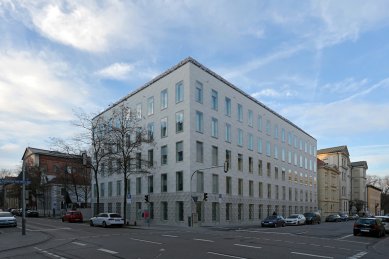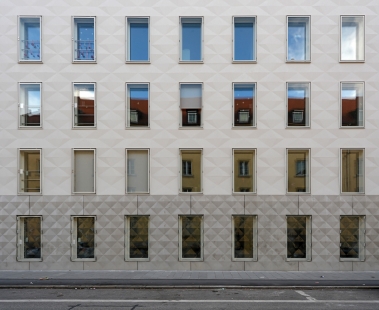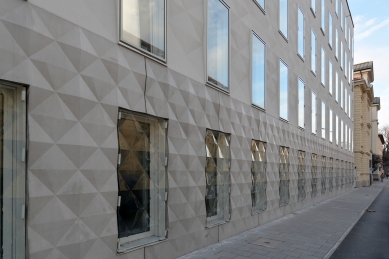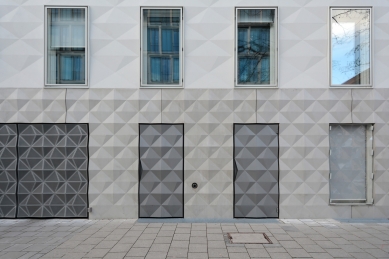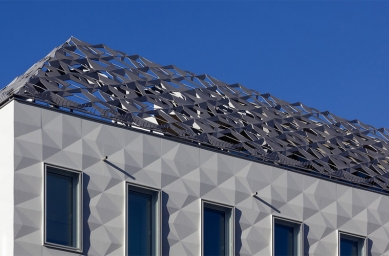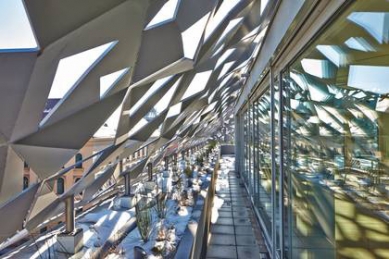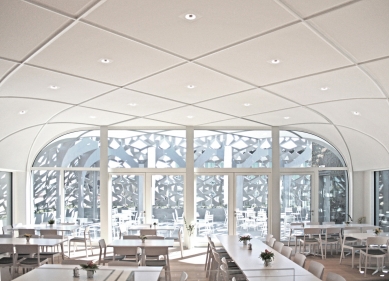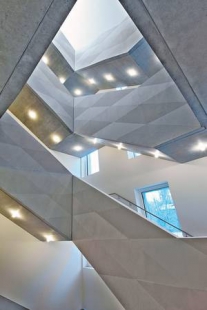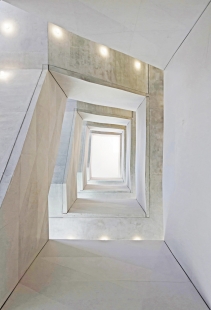
Přístavba úřadu evangelicko luterské zemské církve
Evangelical State Church Office

The extension of the office of the Evangelical Lutheran State Church in Bavaria is proof that corners and edges can look very remarkable: the polygonal facade rightly attracts a lot of attention.
Sunlight dances across the three-dimensional facade. The polygonal surface gives the building on Munich's Katharina von Bora street the appearance of a sculpted statue. The extension for the office of the Evangelical Lutheran State Church in Bavaria appears modern and current, yet does not look disruptive next to the neighboring nearly 90-year-old main building.
The expansion of the building required nearly two years of construction work. The area of 5,700 square meters provides ample space for all the offices of the state church, which were previously scattered in small offices throughout the city. More than 100 employees work in 90 offices. The new building is connected to the main building via walkways.
Visually, the new construction also creates a bridge to the neighboring building: Saarbrücken architects Wolfgang Lorch and Thomas Wandel oriented their design deliberately according to the existing structure from 1929 and interpreted the type of construction, proportions, and division of the facade in a modern version. Original elements have been added, which make the building more interesting: thanks to the honeycomb steel roof and three-dimensionally folded facade, the extension literally protrudes from the street front. At the ceremonial opening of the building, the president of the state church assembly, Annekathrin Preidlová, particularly admired the "breathing" steel roof. She described the broken and folded construction as "the crown of the new building, which looks as if it is lifting towards the sky."
In creating the unusual facade, the decision was made to use elastic polyurethane matrices from RECKLI. Due to their elasticity, the matrices can transfer any motif onto the facade and, depending on the type, can be reused up to 100 times. After the requirement for a pyramid-shaped surface with a smooth structure was decided upon, the RECKLI carpentry workshop, in close collaboration with the customer, created a design model that corresponds to the later surface, known as a positive model. An additional surface sealing of the model ensured that a very smooth surface was created for the elastic matrix.
After acceptance by the customer, the structure was CNC-milled into an MDF model board, which served as the positive model for the matrix. An elastic polyurethane matrix was then produced from this model, which was used during the construction itself.
RECKLI supplied the matrices to the prefabrication LANG (based in Austria), where the elastic molds were glued directly into the formwork, cast with concrete, and created the structure of the concrete elements. After delivery to the construction site, these elements were suspended in front of the facade. A static assessment for the facade was prepared in advance to calculate the weight load of the decorative outer layer. To ensure they could not fall, the elements were additionally anchored to the wall.
The building's equipment matches the striking exterior in every way: geothermal systems, thermal insulation, window and facade areas with optimized thermal protection, and the use of building materials with low pollutant content ensure high sustainability and environmental friendliness; thus, the building conforms to the gold standard of the German Sustainable Building Council.
Sunlight dances across the three-dimensional facade. The polygonal surface gives the building on Munich's Katharina von Bora street the appearance of a sculpted statue. The extension for the office of the Evangelical Lutheran State Church in Bavaria appears modern and current, yet does not look disruptive next to the neighboring nearly 90-year-old main building.
The expansion of the building required nearly two years of construction work. The area of 5,700 square meters provides ample space for all the offices of the state church, which were previously scattered in small offices throughout the city. More than 100 employees work in 90 offices. The new building is connected to the main building via walkways.
Visually, the new construction also creates a bridge to the neighboring building: Saarbrücken architects Wolfgang Lorch and Thomas Wandel oriented their design deliberately according to the existing structure from 1929 and interpreted the type of construction, proportions, and division of the facade in a modern version. Original elements have been added, which make the building more interesting: thanks to the honeycomb steel roof and three-dimensionally folded facade, the extension literally protrudes from the street front. At the ceremonial opening of the building, the president of the state church assembly, Annekathrin Preidlová, particularly admired the "breathing" steel roof. She described the broken and folded construction as "the crown of the new building, which looks as if it is lifting towards the sky."
In creating the unusual facade, the decision was made to use elastic polyurethane matrices from RECKLI. Due to their elasticity, the matrices can transfer any motif onto the facade and, depending on the type, can be reused up to 100 times. After the requirement for a pyramid-shaped surface with a smooth structure was decided upon, the RECKLI carpentry workshop, in close collaboration with the customer, created a design model that corresponds to the later surface, known as a positive model. An additional surface sealing of the model ensured that a very smooth surface was created for the elastic matrix.
After acceptance by the customer, the structure was CNC-milled into an MDF model board, which served as the positive model for the matrix. An elastic polyurethane matrix was then produced from this model, which was used during the construction itself.
RECKLI supplied the matrices to the prefabrication LANG (based in Austria), where the elastic molds were glued directly into the formwork, cast with concrete, and created the structure of the concrete elements. After delivery to the construction site, these elements were suspended in front of the facade. A static assessment for the facade was prepared in advance to calculate the weight load of the decorative outer layer. To ensure they could not fall, the elements were additionally anchored to the wall.
The building's equipment matches the striking exterior in every way: geothermal systems, thermal insulation, window and facade areas with optimized thermal protection, and the use of building materials with low pollutant content ensure high sustainability and environmental friendliness; thus, the building conforms to the gold standard of the German Sustainable Building Council.
RECKLI GmbH
The English translation is powered by AI tool. Switch to Czech to view the original text source.
0 comments
add comment


